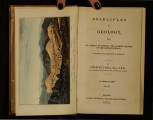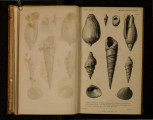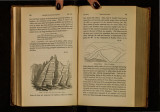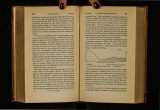| OCR Text |
Show 2! · DIFFERENT ORIGIN OF SECONDARY [Ch. III. to subaqueous deposits formed during the period when the sea prevailed., as contrasted with those that might belong to the subsequent epoch when the land should predominate. First, we may suppose a vast submarine region, such as the bed of the western Atlantic, to receive for ages the turbid waters of several great rivers, like the Amazon, Orinoco, or Mississippi, each draining a considerable continent. The sediment thus introduced might be characterized by a peculiar colour and composition, and the same homogeneous mixture might be spread out over an immense area by the action of a powerful current, like the Gulf-stream. First one submarine basin, and then another, might be filled, or rendered shallow, by the influx of transported matter, the same species of animals and plants still continuing to inhabit the sea, so that the organic, as well as the mineral characters, might be constant throughout the whole series of deposits. In another part of the same ocean, let us suppose masses of coralline and shelly limestone to grow, like those of the Pacific, simultaneously over a space several thousand miles in length, and thirty or forty degrees of latitude in breadth, while volcanic eruptions give rise, at different intervals, to igneous rocks, having a common subaqueous character in different parts of the vast area. It is evident that, during such a state of a certain quarter of the globe, beds of limestone and other rocks might be formed, and retain a common character over spaces equal to a large portion of Europe. State of the Surface when the Tertia1·y G·roups were formed. But when the area under consideration began to be converted into land, a very different condition of things would succeed. A series of subterranean movements might first give rise to small rocks and isles, and then, by subsequent elevations, to larger islands, by the junction of the former. These la11ds would consist partly of the mineral masses before described, whether coralline, sedimentary, or volcanic, and partly Ch. III.] AND TERTIARY STRATA. 25 of the subjacent rocks, whatever they may have been, which constituted the original bed of the ocean. Now the degradation of these lands would commence immediate! y upon their emergence, the waves of the sea undermining the cliffs, and torrents flowing from the surface, so that new strata would begin to form in different places; and in proportion as the lands increased, these deposits would augment. At length by the continued rising and sinking of different parts of the bed of the ocean, a number of distinct basins would be formed, wherein different kinds of sediment, each distinguished by some local character, might accumulate. Some of the groups of isles that had first risen would, in the course o'f ages, become the central mountain ranges of continents, and different lofty chains might thus be characterized by similar rocks of contemporaneous origin, the component strata having originated under analogous circumstances in the ocean before described. Finally, when large tracts of land existed, there would be a variety of disconnected gulfs, inland seas, and lakes, each receiving the drainage of distinct hydrographical basins, and becoming the receptacles of strata distinguished by marked peculiarities of mineral composition. The organic remains would also be more varied, for in one locality freshwater species would be imbedded, as in deposits now forming in the lakes of Switzerland and the north of Italy; in another, marine species, as in the Aral and Caspian; in a third region, gulfs of brackish water would be converted into land, like those of Bothnia and Finland in the Baltic; in a fourth, there might be great fluviatile and marine formations along the borders of a chain of inland seas, like the deltas now growing at the mouths of the Don, Danube, Nile, Po, and Rhone, along the shores of the Azof, Euxine, and Mediterranean. These deposits would each partake more or less of the peculiar mineral character of adjoining lands, the degradation of which would supply sediment to the different rivers. Now if such be, in a great measure, the distinction between |






























































































































































































































































































